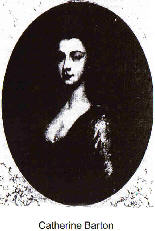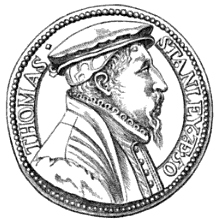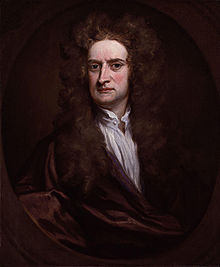
Sir Isaac Newton was an English polymath active as a mathematician, physicist, astronomer, alchemist, theologian, and author who was described in his time as a natural philosopher. He was a key figure in the Scientific Revolution and the Enlightenment that followed. His pioneering book Philosophiæ Naturalis Principia Mathematica, first published in 1687, consolidated many previous results and established classical mechanics. Newton also made seminal contributions to optics, and shares credit with German mathematician Gottfried Wilhelm Leibniz for developing infinitesimal calculus, though notably he developed calculus well before Leibniz. He is considered one of the greatest and most influential scientists in history.

The penny of Great Britain and the United Kingdom from 1714 to 1901, the period in which the House of Hanover reigned, saw the transformation of the penny from a little-used small silver coin to the bronze piece recognisable to modern-day Britons. All bear the portrait of the monarch on the obverse; copper and bronze pennies have a depiction of Britannia, the female personification of Britain, on the reverse.

The Royal Mint is the United Kingdom's official maker of British coins. It is the oldest company in the United Kingdom and is currently located in Llantrisant, Wales, where it moved to in 1968.
Master of the Mint is a title within the Royal Mint given to the most senior person responsible for its operation. It was an important office in the governments of Scotland and England, and later Great Britain and then the United Kingdom, between the 16th and 19th centuries. Until 1699, the appointment was usually for life. Its holder occasionally sat in the cabinet.
The Plumian chair of Astronomy and Experimental Philosophy is one of the major professorships in Astronomy at Cambridge University, alongside the Lowndean Professorship. The chair is currently held at the Institute of Astronomy in the University. The Plumian chair was founded in 1704 by Thomas Plume, a member of Christ's and Archdeacon of Rochester, to "erect an Observatory and to maintain a studious and learned Professor of Astronomy and Experimental Philosophy, and to buy him and his successors utensils and instruments quadrants telescopes etc."

During his residence in London, Isaac Newton had made the acquaintance of John Locke. Locke had taken a very great interest in the new theories of the Principia. He was one of a number of Newton's friends who began to be uneasy and dissatisfied at seeing the most eminent scientific man of his age left to depend upon the meagre remuneration of a college fellowship and a professorship.

The Trial of the Pyx is a judicial ceremony in the United Kingdom to ensure that newly minted coins from the Royal Mint conform to their required dimensional and fineness specifications. Although coin quality is now tested throughout the year under laboratory conditions, the event has become an annual historic tradition. Each year, thousands of coins are put on trial, consisting of both those struck for circulation and non-circulating commemorative coins.

Catherine Barton (1679–1739) was an English homemaker who oversaw the running of the household of her uncle, scientist Isaac Newton. She was reputed to be the source of the story of the apple inspiring Newton's work on gravity, and his papers came to her on his death. She was rumoured to have been the mistress of the poet and statesman Charles Montagu and later married politician John Conduitt.
The British farthing was a British coin worth a quarter of an old penny. It ceased to be struck after 1956 and was demonetised from 1 January 1961.

Thomas Neale (1641–1699) was an English project-manager and politician who was also the first person to hold a position equivalent to postmaster-general of the North American colonies.
John Conduitt, of Cranbury Park, Hampshire, was a British landowner and Whig politician. He sat in the House of Commons from 1721 to 1737. He was married to the half-niece of Sir Isaac Newton, whom Conduitt succeeded as Master of the Mint.
Sir Richard Martin was an English goldsmith and Master of the Mint who served as Sheriff and twice as Lord Mayor of the City of London during the reign of Elizabeth I.
Sir Ralph Freeman was a wealthy English civil judge born in St Mary-at-Hill, Billingsgate, London and lived at Military St Westminster, he was educated at Eton College then at King's College, Cambridge and was called to the Middle Temple bar in 1606 he later received a knighthood in 1617. He was also known as a dramatist and translator. He should not be confused with another contemporary Sir Ralph Freeman who was lord mayor of London, and died on 16 March 1634.

Thomas Stanley was a goldsmith and officer of the Royal Mint in Tudor England. Stanley rose to the rank of Under-Treasurer of the Mint at the Tower of London in the reign of Queen Elizabeth I.
Thomas Egerton was a London merchant and member of the Worshipful Company of Mercers.

Sir Martin Bowes was a very prominent and active civic dignitary of Tudor London whose career continued through the reigns of Henry VIII, Edward VI, Mary I and Elizabeth I. Born into the citizenry of York, Bowes was apprenticed in London and made his career at the Royal Mint, as a master-worker and under-treasurer, and personally implemented the debasement of English currency which became a fiscal imperative in the later reign of Henry.

John Lonyson or Lonison (1525–1582) was an English goldsmith and Master of the Mint in the reign of Elizabeth I.

John Croker, born in Saxony and known in his youth as Johann Crocker, was a master jeweller who migrated to London, where he became a medallist and engraved dies for English and later British coins and medals.
Peter Blondeau was a French moneyer and engineer who was appointed Engineer to the Royal Mint and was responsible for reintroducing milled coinage to England. He pioneered the process of stamping lettering onto the edge of coins.
Chief Engraver of the Royal Mint is a senior position at the British Royal Mint who is responsible for overseeing the preparation of coin dies.












